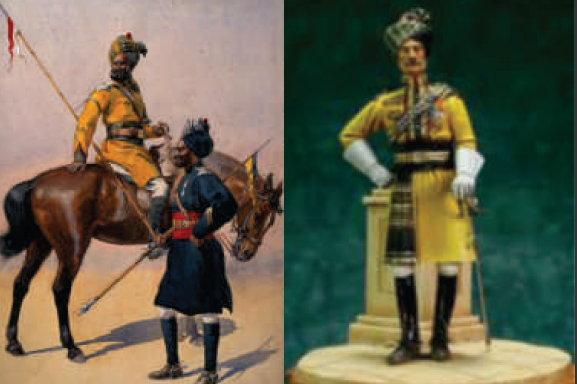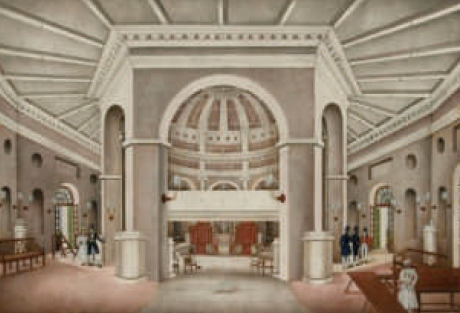Col. James Skinner
This is a collection of articles archived for the excellence of their content. Readers will be able to edit existing articles and post new articles directly |
Hansi's beloved "Sikandar Sahib"
The incredible Col. James Skinner
India Harmony VOLUME - 1 : ISSUE - 5 JULY-AUGUST, 2012
Walking through Welcomgroup ITC's Shikharpur Kothi at Hansi, one senses hushed voices from another era. Nawabi splendour is all around. The mansion overlooks beautiful gardens lovingly tended by a long departed begum. The Lord of this estate was Col James Skinner aka Sikandar Sahib who was awarded the Jagir of Hansi comprising 194 villages in Hisar District by the British rulers of the time, alongwith an annual salary of Rs. 20,000. Legendary tales of his bravery and valor abound in the area. Having survived many epic battles, he took to the lifestyle of a wealthy landlord with aplomb. Visitors to the Kothi would find him holding his Durbar, puffing a Hookah dressed in aristocratic Indian dress of the finest muslins and silks. The house resounded with music, dance and poetry. Festivals of all faiths were celebrated. Having amassed a great fortune as a mercenary soldier he lived in an entirely Mughal style and his principal wife was Muslim. He spoke fluent Persian and as a Mughal courtier of immense importance helped to bridge the gap between the Mughal Court and the British Residents. James Skinner alongwith his friends William Frazer and Sir Thomas Metcalfe was one of the three greatest patrons of the late Mughal painters. He was deeply interested in the lives of the ordinary people and landowners on his estate. He commissioned the Court painter Ghulam Ali Khan to chronicle their lives and invited him to stay on his Hansi estate. He entertained lavishly and his generous hospitality and grand banquets were much coveted. He was a connoisseur of good food and the entire estate was invited to his feasts for visiting dignitaries. As a writer, he recorded in great detail in the Persian language and wrote several books including the famous 'Kitab-i Tasrih al-Aqvam' translated as 'History of the Origin and Distinguishing Marks of the various Indian Castes' and another one named as 'Tazkirat al-Umara' based on biographies of the Sikh and Rajput Princely Families and their Territories along with 37 portraits of their existing generation which was first translated from the Persian language to English by Col. James Skinner CB. Who was this incredible man? How did he achieve in one life time the accolades and honours that would have taken lesser mortals many lifetimes to garner?
Colonel James Skinner CB aka 'Sikandar Sahib' was a renowned Anglo-Indian adventurer born in Kolkata (formerly Calcutta) in 1778 to Lieutenant-Colonel Hercules Skinner of Scottish origin and an officer with the East India Company who married an Indian Rajput Princess. She was taken as a prisoner of war at the tender age of 14 years and kept under the care of Lt.-Col. Hercules Skinner who was then just an Officer of the lower ranks. Later, he married her and together had 6 Children of which 3 were Girls who were later married to East India Company Officers and 3 were Boys named David Skinner who later went to Sea, James Skinner who became the famous Colonel of British India and Robert Skinner who later became a Soldier. James Skinner's mother died when he was just 12 years old and he was sent to Boarding School after completing his basic education from an English School in Kolkata.
James Skinner could not serve as an Officer under the East India Company due to his partial Indian origin but this did not deter the young man. A French Commander named Benoît de Boigne of the Mahratta Army ruled by the Forces of Maharaja Scindia of Gwalior was impressed with the ancestral background of Skinners who had served William of Orange, the King of England during the 11th Century. He allowed James Skinner to join the Mahratta Army as a low rank officer at the age of 16 years under his command. Skinner exuded excellent Military Skills but still remained in the same ranks after Boigne retired and Pierre Cuillier-Perron, a Commander-in-Chief of the Army of Maharaja Scindia took over. Skinner and all Anglo-Indians were dismissed from the Mahratta Army in 1803 when the second Anglo-Maratha War broke out.
James Skinner then joined the British Indian Army under the command of Lord Lake who was the Commander-in-Chief of British India. His generosity, bravery and leadership inspired great loyalty among his soldiers. They refused to leave his service and were ready to die under his command. So on 23rd February 1803, Skinner raised a regiment of light cavalry and named it as '1st Skinner's Horse' or 'Yellow Boys' as their uniforms were yellow in colour. After the immense success of this first regiment, Skinner raised another regiment of light cavalry named as '3rd Skinner's Horse' (renamed today as '2nd Skinner's Horse). Both these regiments of light cavalry exist even today as a part of the Indian Army. In 1828, he earned the rank of a Lieutenant-Colonel while his brother, Robert Skinner, earned the rank of a Major. James Skinner eventually became the Colonel of British India and was honoured as CB.
Colonel James Skinner CB is also known for the magnificent Church he built in Delhi. He had promised God that he would construct a Church if he came alive from the battle field at Uniara where he lay badly wounded in the year 1800. God answered his prayers and Skinner survived the battle and to keep his promise, financed an amount of INR 95,000 to construct a Church. The Church was designed by Major Robert Smith and its construction commenced in 1826 and was completed in 1836. Rev. Daniel Wilson, the Bishop of Kolkata consecrated the Church on 21st November 1836 and named it as 'St. James Church' after Colonel James Skinner CB. It is one of the oldest Churches in Delhi. He is also said to have constructed a Temple and a Mosque in Delhi but detailed information about them remains unknown.
The St. James Church depicts excellent Renaissance style seen in the shape of a 'Cruciform' or 'Greek Cross' which reveals a octagonal dome shaped central roof that imitates the Florence Cathedral in Florence in Italy and three portico porches which is an open front platform with a roof supported by massive columns that forms the entrance of this Church and the large framed windows are seen covered with elaborate and colourful stained glass. The Church has a Copper Ball and a Cross on top which is an imitation of the Church in Venice but unfortunately got damaged during the 1857 Uprising (Sepoy Mutiny); however, they were reconstructed and every effort was made to ensure that they maintain their original shape.
Col. James Skinner CB died on 4th December 1841 at Hansi and was buried with complete rituals within the compound of the Cantonment Burial Ground at Hansi. After 40 days, his grave was disinterred and the coffin was moved to Delhi which was escorted by 200 men of the 'Skinner's Horse' Regiment Cavalry. On 19th January 1842, he was buried within the Cemetery grounds of St. James Church and inside a vault made of white marble that lies just below the Communion Altar Table. In the Cemetery grounds of this Church also lie buried his dearest friends and fellow orientalists the famous British Commissioner Sir William Frazer and Sir Thomas Metcalfe (1795 to 1853) who was a British Agent and Commissioner to the Governor-General of British India and lived in Delhi for 40 years. He was famed for his 'Metcalfe Houses' and lies buried in the Church within his own Family Plot which he had acquired before his death. The Church was later used by the Viceroys as a revered place of worship till 1947. Descendants of Col. James Skinner are Christians, Hindus and Muslims and can be found in India, Pakistan, Australia and the UK depending on the faith they chose to follow after independence. The Kothi and his Estates in Hansi, Delhi and Mussoorie continue to belong to branches of the family.
The magnificent St. James Church has been recently renovated and attracts tourists and worshippers in present day Delhi. Here then stands the legacy of a child of mixed parentage, son of a Christian father and Hindu mother shunned by both faiths in his early years, remained a practicing Christian to the very end. Married to a devout Muslim woman he did not relinquish his Christian faith nor did he ask her to relinquish her beliefs. Col. James Skinner has, over the last 200 years, finally made a place for himself in the hearts and minds of both the British and Indian rulers as a great and true son of Hindustan.





